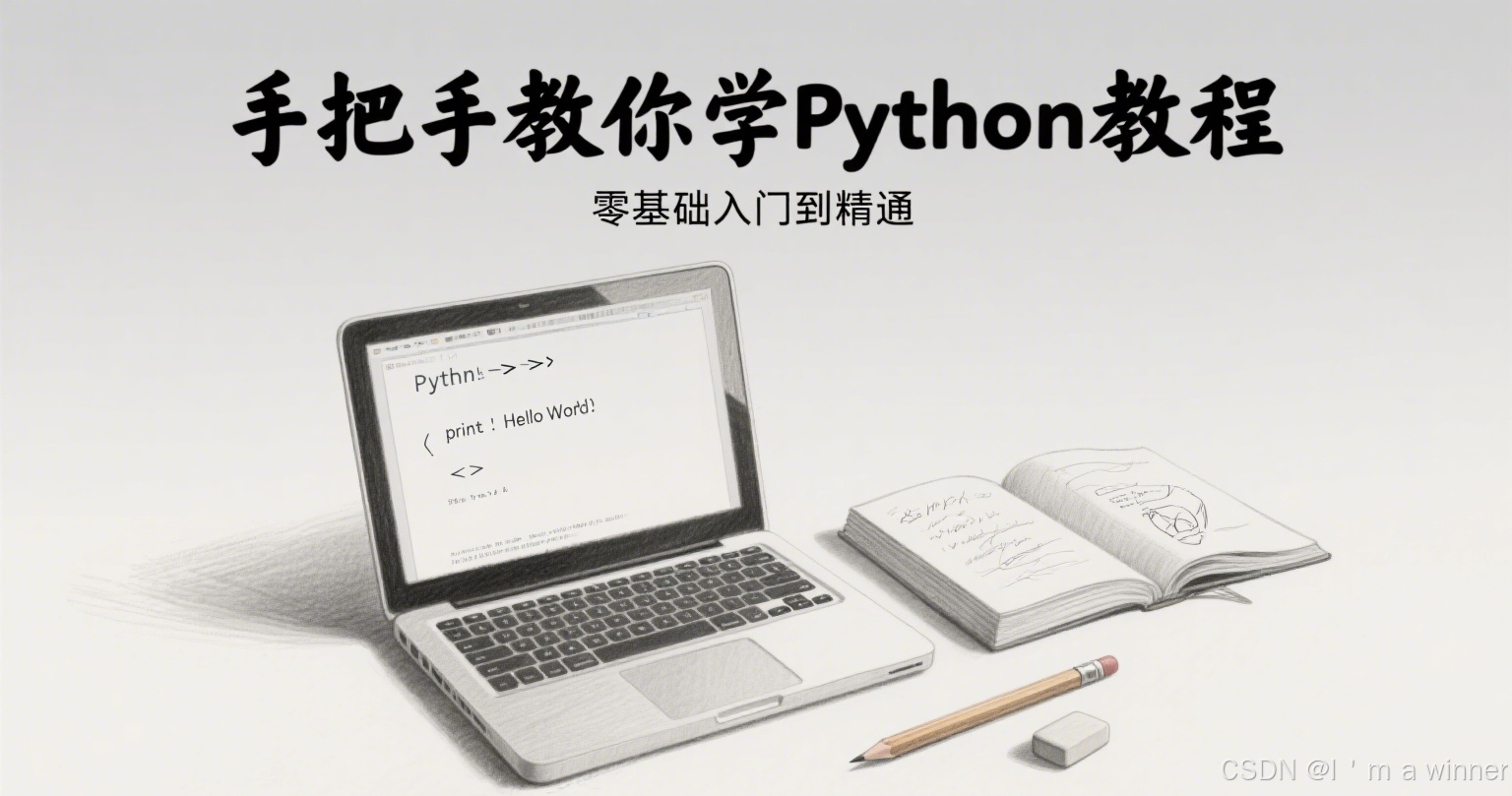第七章:AI进阶之------输入与输出函数(一)
本文介绍了Python中的输入输出函数,重点讲解print()和input()的使用方法。print()函数用于输出内容,支持格式化输出(%占位符、format()方法和f-strings),并详细说明了各种格式化方式的语法和示例。同时指出了格式化输出中常见的类型不匹配和变量包裹错误。通过本文可以掌握Python程序的基本交互功能,包括接收用户输入和输出结果。


文章目录
一、引言
欢迎来到 Python 输入与输出函数的课程!在之前的课程中,我们已经学习了 Python 的基本数据类型、变量与赋值语句。今天,我们将学习如何与用户进行交互,通过输入函数获取用户的输入,以及通过输出函数向用户展示结果。
在 Python 编程中,输入输出(I/O)是程序与用户交互的基础。通过输入函数,程序可以接收用户的输入数据;通过输出函数,程序可以向用户展示处理结果。掌握输入输出函数的使用,是编写交互式程序的关键。
本节课的学习目标:
-
掌握 print () 函数的使用,包括打印单个 / 多个内容、格式化输出
-
掌握 input () 函数的使用,包括获取用户输入和输入内容的类型转换
-
能够编写简单的交互式程序,处理用户输入并输出结果
-
理解并避免输入输出函数使用过程中的常见错误
现在,让我们开始今天的学习!
二、输出函数 print ()
2.1 print () 函数基础
在 Python 中,print () 函数是最常用的输出函数,用于向控制台输出文本信息。它的基本语法如下:
print(*objects, sep=' ', end='\n', file=sys.stdout, flush=False)
其中,参数说明:
-
objects:要打印的一个或多个对象,可以是字符串、数字、列表等任何可打印的数据类型
-
sep:分隔符,用于分隔多个对象,默认值为一个空格
-
end:结束符,用于指定打印结束后添加的字符,默认值为换行符 ‘\n’
-
file:输出目标,可以是文件对象或标准输出(默认值为 sys.stdout)
-
flush:是否立即刷新缓冲区,默认值为 False
示例 1:打印单个内容
print("Hello, World!") # 输出字符串
print(42) # 输出整数
print(3.14) # 输出浮点数
print([1, 2, 3]) # 输出列表
示例 2:打印多个内容
print("My name is", "Alice") # 输出:My name is Alice
print("The sum of 3 and 5 is", 3 + 5) # 输出:The sum of 3 and 5 is 8
示例 3:使用 sep 参数自定义分隔符
print("apple", "banana", "cherry", sep=", ") # 输出:apple, banana, cherry
print("Hello", "World", sep="**") # 输出:Hello**World
示例 4:使用 end 参数自定义结束符
print("Hello", end=" ") # 不换行,以空格结束
print("World!") # 输出:Hello World!
2.2 格式化输出
在实际应用中,我们经常需要将变量的值插入到字符串中,形成具有一定格式的输出。Python 提供了多种格式化输出的方式,包括 % 占位符、format () 方法和 f-strings。
2.2.1 使用 % 占位符进行格式化
% 占位符是 Python 中较早期的格式化方法,类似于 C 语言中的 printf 函数。其基本语法如下:
print("格式化字符串" % 变量)
示例 1:基本格式化
name = "Alice"
age = 30
print("My name is %s and I am %d years old." % (name, age))
# 输出:My name is Alice and I am 30 years old.
示例 2:格式化浮点数
pi = 3.1415926535
print("Pi is approximately %.2f" % pi) # 输出:Pi is approximately 3.14
示例 3:使用多个占位符
print("The sum of %d and %d is %d." % (3, 5, 8))
# 输出:The sum of 3 and 5 is 8.
常用的 % 占位符:
| 占位符 | 说明 |
|---|---|
| %s | 字符串 |
| %d | 整数 |
| %f | 浮点数 |
| %x/%X | 十六进制数 |
| %o | 八进制数 |
| %% | 百分号本身 |
示例 4:其他占位符的使用
print("Octal: %o" % 255) # 八进制:377
print("Hexadecimal: %x" % 255) # 十六进制:ff
print("Percentage: %.2f%%" % 85.5) # 百分比:85.50%
2.2.2 使用 format () 方法进行格式化
format () 方法是 Python 2.6 及以上版本引入的格式化方法,比 % 占位符更加灵活和强大。其基本语法如下:
print("格式化字符串".format(变量))
示例 1:基本格式化
name = "Alice"
age = 30
print("My name is {} and I am {} years old.".format(name, age))
# 输出:My name is Alice and I am 30 years old.
示例 2:使用位置参数
print("{0} is {1} years old. {0} is a programmer.".format("Alice", 30))
# 输出:Alice is 30 years old. Alice is a programmer.
示例 3:使用关键字参数
print("My name is {name} and I am {age} years old.".format(name="Alice", age=30))
# 输出:My name is Alice and I am 30 years old.
示例 4:格式化浮点数
pi = 3.1415926535
print("Pi is approximately {:.2f}".format(pi)) # 输出:Pi is approximately 3.14
示例 5:指定字段宽度和对齐方式
print("{:<10} | {:^10} | {:>10}".format("Left", "Center", "Right"))
# 输出:Left | Center | Right
示例 6:使用填充字符
print("{:*^20}".format("Python")) # 输出:****Python****
2.2.3 使用 f-strings 进行格式化(Python 3.6+)
f-strings 是 Python 3.6 及以上版本引入的一种新的格式化方法,它简洁、高效且易于阅读,是目前推荐使用的格式化方式。其基本语法如下:
print(f"格式化字符串{变量}")
示例 1:基本格式化
name = "Alice"
age = 30
print(f"My name is {name} and I am {age} years old.")
# 输出:My name is Alice and I am 30 years old.
示例 2:表达式和计算
print(f"The sum of 3 and 5 is {3 + 5}") # 输出:The sum of 3 and 5 is 8
print(f"5 multiplied by 3 is {5 * 3}") # 输出:5 multiplied by 3 is 15
示例 3:格式化浮点数
pi = 3.1415926535
print(f"Pi is approximately {pi:.2f}") # 输出:Pi is approximately 3.14
示例 4:指定字段宽度和对齐方式
print(f"{'Left':<10} | {'Center':^10} | {'Right':>10}")
# 输出:Left | Center | Right
示例 5:使用填充字符
print(f"{'Python':*^20}") # 输出:****Python****
2.3 格式化输出易错点
在使用格式化输出时,初学者容易犯以下错误:
错误 1:占位符类型与变量类型不匹配
# 错误示例:%d用于字符串变量
name = "Alice"
print("My name is %d" % name) # 错误:TypeError: %d format: a number is required, not str
错误原因:% d 占位符需要整数类型,而变量 name 是字符串类型。
解决方案:使用正确的占位符类型:
name = "Alice"
print("My name is %s" % name) # 正确:使用%s占位符
错误 2:忘记使用元组包裹多个变量
# 错误示例:缺少括号
name = "Alice"
age = 30
print("My name is %s and I am %d years old." % name, age) # 错误:TypeError
错误原因:当使用多个变量时,必须用元组包裹。
解决方案:使用括号包裹多个变量:
print("My name is %s and I am %d years old." % (name, age)) # 正确
错误 3:在 format () 方法中使用错误的索引
# 错误示例:索引超出范围
print("{1} is {0} years old.".format("Alice", 30)) # 错误:IndexError
错误原因:索引从 0 开始,所以第一个参数是 {0},第二个是 {1}。
解决方案:正确使用索引:
print("{0} is {1} years old.".format("Alice", 30)) # 正确
错误 4:在 f-string 中错误地使用引号
# 错误示例:引号冲突
print(f"She said, "Hello!") # 错误:SyntaxError
错误原因:f-string 中的引号与字符串中的引号冲突。
解决方案:使用不同类型的引号:
print(f'She said, "Hello!"') # 正确
print(f"She said, 'Hello!'") # 正确
后续见下章》》》》》》

更多推荐
 已为社区贡献15条内容
已为社区贡献15条内容







所有评论(0)